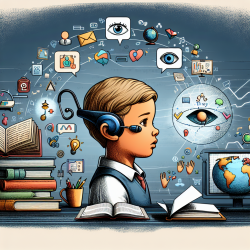Paediatric hearing loss is a growing public health issue that significantly impacts children's educational outcomes. A recent research article, "Meeting the educational needs of children with hearing loss" by Karissa L LeClair and James E Saunders, published in the Bulletin of the World Health Organization, sheds light on the severe implications of untreated hearing loss on children's education. Here, we will discuss key findings from the study and provide actionable insights for practitioners to improve their skills and encourage further research.### The Stark Reality of Hearing Loss in ChildrenThe study reveals that children with any degree of hearing impairment tend to exhibit poor language development, leading to lower literacy rates, diminished social skills, and impaired executive function capacity. This is particularly alarming given that even mild hearing loss (26–40 dB) affects nearly 50 million children worldwide. These children are over 2.5 times more likely to face academic difficulties, with 37% of children with mild hearing loss having failed at least one grade.### Severity MattersThe impact of hearing loss on education varies with its severity:- **Mild Hearing Loss (26–40 dB):** Compromised speech recognition and poorer language skills.- **Moderate Hearing Loss (41–60 dB):** Similar educational impairments as mild hearing loss but more common and impactful.- **Severe to Profound Hearing Loss (61 dB and above):** Significantly hindered academic achievement, with one-third of children functionally illiterate upon graduation from secondary school.### Unilateral Hearing Loss: An Overlooked IssueChildren with unilateral hearing loss (hearing impairment in one ear) also face educational barriers similar to those with mild deficits. This condition affects sound localization and hearing in noisy environments like classrooms, leading to lower oral language scores compared to their normal-hearing peers.### Global Prevalence and DisparitiesThe global prevalence of childhood hearing loss shows significant regional variability. Low- and middle-income countries bear a disproportionate burden, with high rates of mild to severe hearing loss and limited access to hearing health care. In contrast, high-income countries report lower prevalence rates and better access to treatment.### Preventive Measures and Early InterventionThe study highlights that 60% of paediatric hearing loss is preventable through measures such as:- Vaccinations to prevent rubella-associated hearing loss.- Treatment for otitis media to address chronic ear infections.- Awareness campaigns about the ototoxic effects of unregulated antibiotic use and safe maternal practices.Early detection and treatment are crucial. Newborn hearing screening can lead to early intervention, significantly improving language and educational outcomes. For instance, children with profound hearing loss who receive early diagnosis and treatment, including hearing amplification and cochlear implantation, can achieve speech and language levels equal to their hearing peers.### Actionable Steps for Practitioners1. **Expand Awareness:** Educate parents and health providers about the signs of hearing loss and the importance of early intervention.2. **Implement Newborn Screening:** Advocate for standardized newborn hearing screening programs.3. **Provide Resources:** Ensure that schools have the necessary resources to support children with hearing loss.4. **Encourage Preventive Care:** Promote vaccinations and treatments to prevent hearing loss.5. **Foster Inclusive Education:** Work towards integrating children with hearing loss into mainstream education.### ConclusionAddressing paediatric hearing loss is essential for achieving quality education for all, as mandated by Sustainable Development Goal 4. By implementing preventive measures, early detection, and inclusive educational practices, we can significantly improve the educational outcomes for children with hearing loss.To read the original research paper, please follow this link:
Meeting the educational needs of children with hearing loss.


